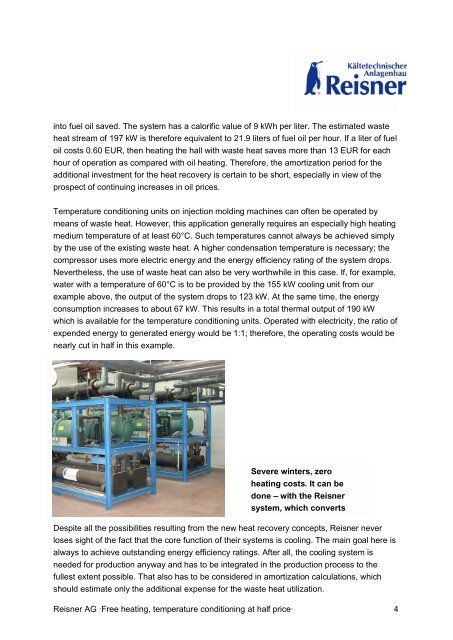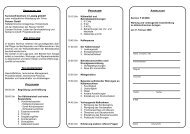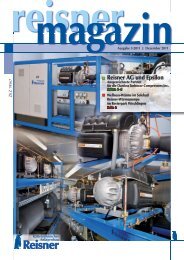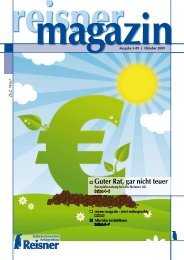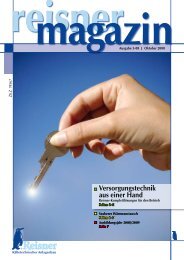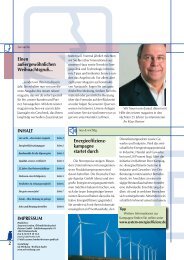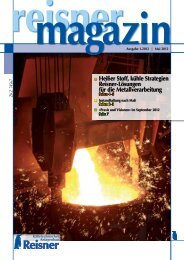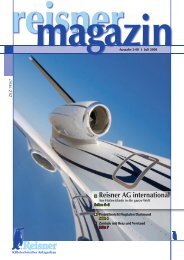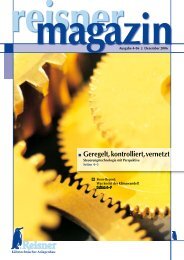Free heating, temperature conditioning at half price - Reisner AG
Free heating, temperature conditioning at half price - Reisner AG
Free heating, temperature conditioning at half price - Reisner AG
You also want an ePaper? Increase the reach of your titles
YUMPU automatically turns print PDFs into web optimized ePapers that Google loves.
into fuel oil saved. The system has a calorific value of 9 kWh per liter. The estim<strong>at</strong>ed waste<br />
he<strong>at</strong> stream of 197 kW is therefore equivalent to 21.9 liters of fuel oil per hour. If a liter of fuel<br />
oil costs 0.60 EUR, then <strong>he<strong>at</strong>ing</strong> the hall with waste he<strong>at</strong> saves more than 13 EUR for each<br />
hour of oper<strong>at</strong>ion as compared with oil <strong>he<strong>at</strong>ing</strong>. Therefore, the amortiz<strong>at</strong>ion period for the<br />
additional investment for the he<strong>at</strong> recovery is certain to be short, especially in view of the<br />
prospect of continuing increases in oil <strong>price</strong>s.<br />
Temper<strong>at</strong>ure <strong>conditioning</strong> units on injection molding machines can often be oper<strong>at</strong>ed by<br />
means of waste he<strong>at</strong>. However, this applic<strong>at</strong>ion generally requires an especially high <strong>he<strong>at</strong>ing</strong><br />
medium <strong>temper<strong>at</strong>ure</strong> of <strong>at</strong> least 60°C. Such <strong>temper<strong>at</strong>ure</strong>s cannot always be achieved simply<br />
by the use of the existing waste he<strong>at</strong>. A higher condens<strong>at</strong>ion <strong>temper<strong>at</strong>ure</strong> is necessary; the<br />
compressor uses more electric energy and the energy efficiency r<strong>at</strong>ing of the system drops.<br />
Nevertheless, the use of waste he<strong>at</strong> can also be very worthwhile in this case. If, for example,<br />
w<strong>at</strong>er with a <strong>temper<strong>at</strong>ure</strong> of 60°C is to be provided by the 155 kW cooling unit from our<br />
example above, the output of the system drops to 123 kW. At the same time, the energy<br />
consumption increases to about 67 kW. This results in a total thermal output of 190 kW<br />
which is available for the <strong>temper<strong>at</strong>ure</strong> <strong>conditioning</strong> units. Oper<strong>at</strong>ed with electricity, the r<strong>at</strong>io of<br />
expended energy to gener<strong>at</strong>ed energy would be 1:1; therefore, the oper<strong>at</strong>ing costs would be<br />
nearly cut in <strong>half</strong> in this example.<br />
Severe winters, zero<br />
<strong>he<strong>at</strong>ing</strong> costs. It can be<br />
done – with the <strong>Reisner</strong><br />
system, which converts<br />
Despite all the possibilities resulting from the new he<strong>at</strong> recovery concepts, <strong>Reisner</strong> never<br />
loses sight of the fact th<strong>at</strong> the core function of their systems is cooling. The main goal here is<br />
always to achieve outstanding energy efficiency r<strong>at</strong>ings. After all, the cooling system is<br />
needed for production anyway and has to be integr<strong>at</strong>ed in the production process to the<br />
fullest extent possible. Th<strong>at</strong> also has to be considered in amortiz<strong>at</strong>ion calcul<strong>at</strong>ions, which<br />
should estim<strong>at</strong>e only the additional expense for the waste he<strong>at</strong> utiliz<strong>at</strong>ion.<br />
<strong>Reisner</strong> <strong>AG</strong> ·<strong>Free</strong> <strong>he<strong>at</strong>ing</strong>, <strong>temper<strong>at</strong>ure</strong> <strong>conditioning</strong> <strong>at</strong> <strong>half</strong> <strong>price</strong>· 4


